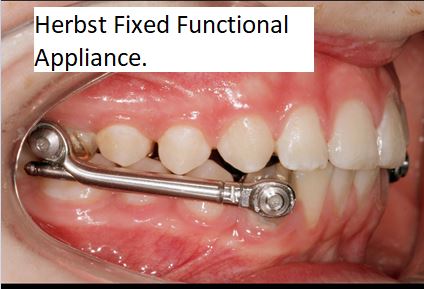It has been a dream of orthodontists and their patients for over a hundred years that we could get an orthodontic appliance to encourage the jaws to grow in the amount and direction required to correct the small lower jaw. This is obviously a very attractive proposition for parents and their parents. Can functional appliances really make the jaws grow? Is there really a way to change the size of a jaw without surgery?
What are Functional Appliances ?
There are numerous types of functional appliances, and they are all designed to work based on the same principle, they encourage the patient to Function (chew, bite, and rest) with the lower jaw in an improved position. The lower jaw is postured forwards and downwards into the improved position.The basic principle behind functional appliances is that the body will respond to this “encouragement” and grow the jaw in the desired direction.
Some functional appliances like the Twin Block are removable. These can be taken out for eating and cleaning, but it is very important that they are replaced immediately afterwards.Patients must wear them as close to 24 hours a day as possible.
Other functional appliances like the Herbst appliance are fixed and cannot be removed. This has the advantage that the patient does not have to remember to put them in.
Example of a 10 year old boy with a 15 mm overjet treated by Twin Block functional appliances followed fixed appliances.
After treatment.
All functional appliances use the teeth in the upper and lower jaws to attach the functional appliance onto, to posture the lower jaw forwards. This means the teeth are subjected to a force from the functional appliance. When the twin blocks are positioned the lower jaw is postured forwards. The muscles and other soft tissues tend to pull the lower jaw back to its unpostured position. This applies a backward force to the upper teeth and a forwards force to the lower teeth. When a force is applied to teeth they move in the direction of that force through the existing bone. Here the Twin Blocks pushed the patients upper teeth back and widened the upper arch (teeth) side ways, it also pushed the lower teeth forwards . This is how his overjet was reduced back to normal values. But do functional appliances also make the lower jaw grow more than it would have anyway? ……
Detailed orthodontic research shows that functional appliances are really great at moving teeth but do not grow the lower jaw to any significant extent.
The size and shape of our jaws is determined by our genes and orthodontic functional appliances work by moving the teeth through the existing bone they do not make the lower jaw bigger. That is functional appliances achieve dental changes (as shown in the case above), the size and shape of the jaws remains essentially unchanged , but the upper and lower teeth meet together better as a result of the upper teeth moving backwards through the existing bone and the lower teeth moving forwards through the existing bone.
Even though functional appliances work by moving the teeth rather than growing the lower jaw, they are still invaluable appliances in orthodontics in suitable patients like the case described above. They are used very frequently by John Buckley in Clonmel Orthodontics.
…………………………………………………………………………………………………………………………….
This orthodontic blog was written by Dr John Buckley,who is a specialist orthodontist at Clonmel Orthodontics in Clonmel County Tipperary, Ireland.He is both Clonmel’s most qualified and most experienced orthodontist.
Clonmel Orthodontics provides orthodontics to county Tipperary and the neighbouring counties of Waterford, Kilkenny, Limerick,Cork , and beyond.
Dr Buckley has practised as a specialist orthodontist in Clonmel for over 20 years. In addition to his orthodontic qualifications which he held before he commenced orthodontic practice , Dr Buckley was awarded a First class masters degree in Lingual orthodontics from the University of Hannover medical school (MHH) in 2012. This masters degree is directed by Professor Dirk Wiechmann who is the inventor of both the incognito™ and win™ lingual appliances. Dr Buckley was the first orthodontist in Ireland to be awarded this qualification. In 2016 he was accepted as an active member of the European Society Of Lingual Orthodontics (ESLO). To become an active member it is necessary for candidates to submit the records of finished lingual cases. If the cases are deemed to be of a sufficiently high standard then the candidate is accepted as an active member of ESLO. Dr Buckley is the first and only orthodontist in Ireland to be accepted as an active member of ESLO.







